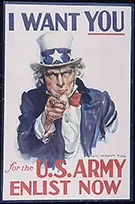After World War 2
The world was a very different place after World War II. Millions of people were dead. Much of Europe and the Pacific lay in ruins. Rebuilding required money, manpower and resources. Many businesses had joined the war effort, turning out airplanes and mess kits instead of building materials and dresses. Even in the United States, a country that had very little damage from the war, things changed. Life for most of the world was completely different after World War II.

The Role of Women. During the Second World War, the army drafted men for military service. Women could join the military, but they couldn’t serve near battle lines. So many women stayed at home. But, manufacturing still needed workers. With the men gone, they turned to women. To encourage women to work for the war effort, women were told it was glamorous and patriotic to work. Characters like “Rosie the Riveter” showed women that they were strong too.

Most people thought that when the soldiers came home, the women would go back to being homemakers and teachers. But that’s not what happened. Many women enjoyed the independence that came with having a job. Many women continued to work, even after the servicemen came home. They also learned the value of education. While many women who worked during WWII didn’t even have a high school diploma, they learned the value of education. More of these women made sure that their daughters graduated from high school, and many fought for their daughters to go to college.

The G.I. Bill. Soldiers came home from war different. Many left not long after their 18th birthday. But six years of fighting changed them. When they came home, they weren’t kids anymore. To help soldiers, President Roosevelt signed the Serviceman’s Readjustment Act. This bill rewarded soldiers for their service in new ways. It provided government backed loans so that soldiers could buy homes or start businesses.
It gave soldiers cash to go back to school or even get a college education. Many soldiers took advantage of the G.I. Bill. Soldiers that would never have been able to go to college became doctors and lawyers. Others built new homes in rapidly growing suburbs. In many ways, the GI Bill created the growth of the middle class.

Baby Boom. Men who used the G.I. Bill felt that they had more money and security than ever before. Many of these men had grown up during the Great Depression and had known poverty most of their lives. The security of owning a home or a business helped them feel ready to have a family. Not only did marriage rates skyrocket in the years after the war, but also new babies.
In the last year of the war, less than a million babies were born in the entire United States. By 1954, more than 4 million babies were born every year. Thus meant that many families didn’t stop at just one or two children, but went on to have a larger family with three four or even five children. By 1965, 40% of the people in the United States were under 20.

Nuclear Fears. When the United States dropped the atomic bomb on Hiroshima, the world changed. Footage of the bomb and its damage made everyone aware of the dangers of nuclear weapons. Never before had any nation seen the kind of destruction that nuclear bombs can do. The Soviets were the allies of the United States during the war, but it was an uneasy friendship.
Before long, The Soviets had their own nuclear bomb. People became afraid of a war that might feature nuclear weapons. To help ease their fears, the U.S. government taught people what to do in the event of a nuclear attack. Children practiced nuclear drills at school. Theatres showed films featuring a happy upbeat song called “Duck and Cover,” designed to ease people’s fears.

Rebuilding Japan and Germany. Unlike other periods in history, the United States had no desire to keep the territory captured during the war. Almost before the ink dried on the surrender papers, the United States began to help Germany and Japan rebuild from the war. In Japan, military contractors helped Japanese businesses develop so that the country could once again take its place in the world.
Germany was a little more difficult. Stalin did not share the United States opinion of what should happen to Germany. He wanted to keep the German territory he had gained in war. The United States and the Soviets split Germany right down the middle. East Germany became a part of the Soviet Union. West Germany was an independent nation. A wall split the nation’s capital, Berlin, right down the middle. The wall stood until 1990, when East and West Germany reunited.



